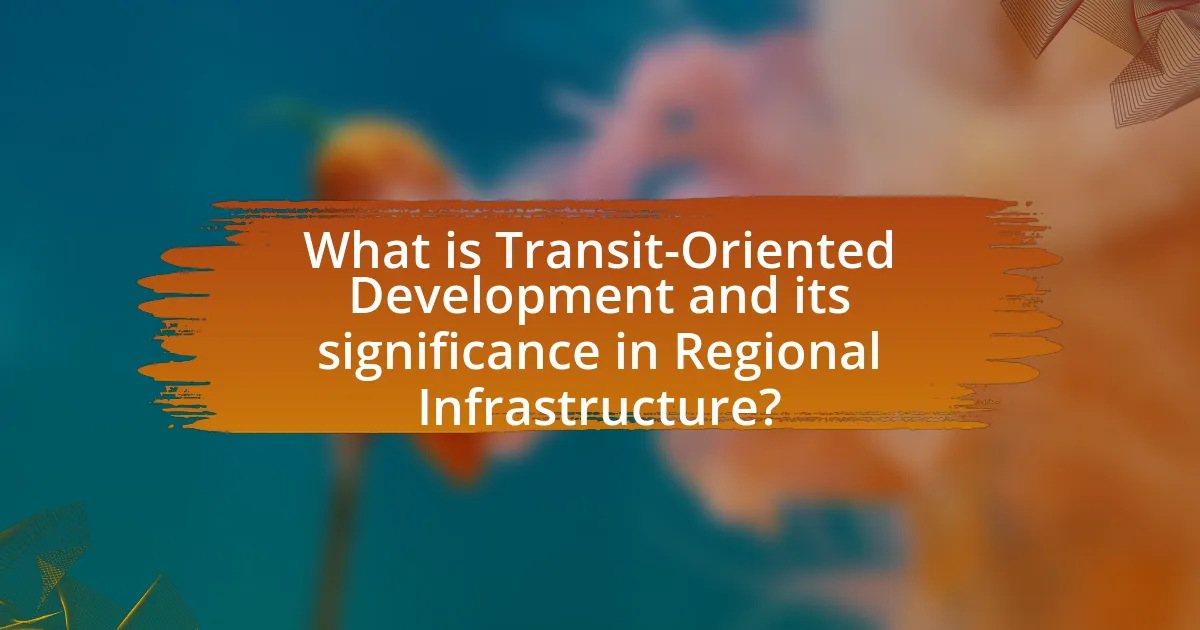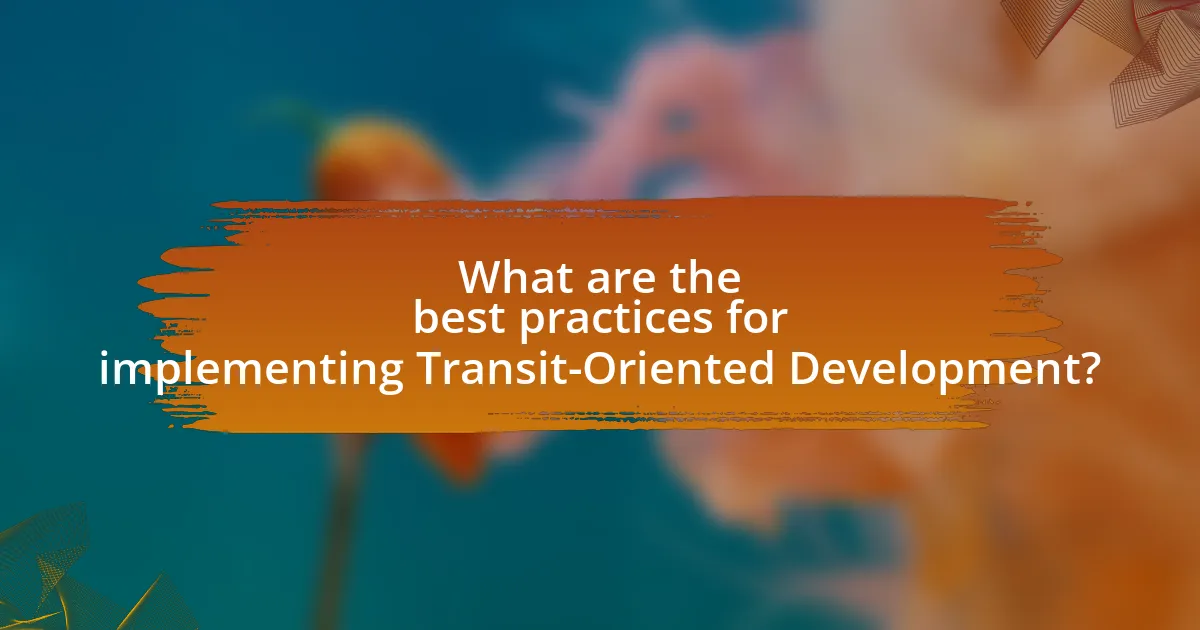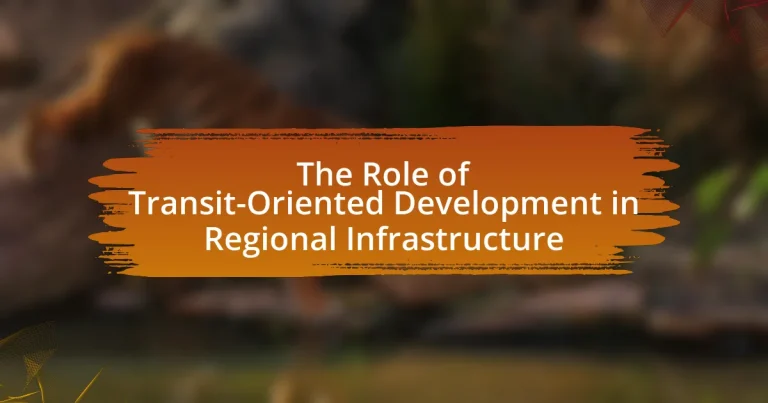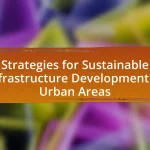Transit-Oriented Development (TOD) is a strategic planning approach that emphasizes the creation of compact, walkable communities centered around efficient public transportation systems. This article explores the significance of TOD in enhancing regional infrastructure by reducing automobile dependency, promoting sustainable land use, and improving accessibility to transit options. Key principles of TOD include mixed-use development, high-density housing, and pedestrian-friendly design, which collectively foster economic growth, increase property values, and enhance community connectivity. Additionally, the article addresses the social benefits of TOD, such as promoting social equity and improving community health, while also discussing the challenges and best practices for successful implementation.

What is Transit-Oriented Development and its significance in Regional Infrastructure?
Transit-Oriented Development (TOD) is a planning strategy that focuses on creating compact, walkable communities centered around high-quality public transportation systems. The significance of TOD in regional infrastructure lies in its ability to reduce reliance on automobiles, promote sustainable land use, and enhance accessibility to transit options. Studies indicate that areas developed with TOD principles can lead to a 20-40% reduction in vehicle miles traveled, thereby decreasing traffic congestion and lowering greenhouse gas emissions. Furthermore, TOD fosters economic growth by increasing property values and attracting businesses, which contributes to the overall vitality of the region.
How does Transit-Oriented Development influence urban planning?
Transit-Oriented Development (TOD) significantly influences urban planning by promoting higher density, mixed-use development around transit hubs, which enhances accessibility and reduces reliance on automobiles. This approach encourages the integration of residential, commercial, and recreational spaces, fostering vibrant communities and efficient land use. For instance, cities that implement TOD strategies often see a decrease in traffic congestion and an increase in public transit ridership, as evidenced by a study from the Victoria Transport Policy Institute, which found that TOD can reduce vehicle miles traveled by up to 30%. Additionally, TOD contributes to sustainable urban growth by minimizing urban sprawl and promoting environmentally friendly transportation options.
What are the key principles of Transit-Oriented Development?
The key principles of Transit-Oriented Development (TOD) include mixed-use development, high-density housing, pedestrian-friendly design, and proximity to public transit. Mixed-use development integrates residential, commercial, and recreational spaces, promoting vibrant communities. High-density housing supports efficient land use and reduces reliance on automobiles, as seen in cities like Portland, Oregon, where TOD has led to increased public transit ridership. Pedestrian-friendly design enhances accessibility and encourages walking, contributing to healthier lifestyles. Proximity to public transit ensures that residents have convenient access to transportation options, which is crucial for reducing traffic congestion and lowering carbon emissions. These principles collectively aim to create sustainable, livable communities that prioritize public transit and reduce dependence on cars.
How does Transit-Oriented Development promote sustainable transportation?
Transit-Oriented Development (TOD) promotes sustainable transportation by integrating residential, commercial, and recreational spaces within walking distance of public transit hubs. This design encourages the use of public transportation, reducing reliance on personal vehicles. Studies show that areas developed with TOD principles can increase public transit ridership by up to 30%, leading to decreased greenhouse gas emissions and lower traffic congestion. Additionally, TOD fosters a mixed-use environment that supports active transportation modes, such as walking and cycling, further enhancing sustainability in urban planning.
What are the economic impacts of Transit-Oriented Development?
Transit-Oriented Development (TOD) significantly enhances local economies by increasing property values, boosting retail activity, and attracting businesses. Studies indicate that properties near transit stations can see value increases of 10% to 30% compared to those further away, as evidenced by research from the National Association of Realtors. Additionally, TOD encourages higher density development, which can lead to increased tax revenues for municipalities. For instance, cities that have implemented TOD strategies often report a rise in sales tax revenue due to the influx of residents and visitors utilizing public transit. Furthermore, TOD promotes job creation in construction, retail, and service sectors, contributing to overall economic growth.
How does Transit-Oriented Development affect property values?
Transit-Oriented Development (TOD) generally increases property values due to its proximity to public transportation, which enhances accessibility and desirability. Studies have shown that properties located within a half-mile radius of transit stations can see value increases of 10% to 30% compared to similar properties further away. For instance, a report by the Victoria Transport Policy Institute indicates that residential properties near transit hubs often command higher prices because of reduced commuting costs and improved convenience. Additionally, TOD areas typically attract more businesses and amenities, further driving up local property values.
What role does Transit-Oriented Development play in job creation?
Transit-Oriented Development (TOD) significantly enhances job creation by concentrating employment opportunities near public transit hubs. This proximity encourages businesses to establish themselves in these areas, leading to increased local employment. For instance, a study by the American Public Transportation Association found that regions with robust TOD initiatives experienced a 20% increase in jobs compared to those without such developments. Additionally, TOD fosters a diverse mix of residential, commercial, and recreational spaces, which attracts a workforce that relies on public transportation, further stimulating economic growth and job opportunities.

How does Transit-Oriented Development enhance community connectivity?
Transit-Oriented Development enhances community connectivity by integrating residential, commercial, and public transport facilities within close proximity. This design encourages walking, cycling, and the use of public transit, reducing reliance on automobiles. Studies show that areas developed with transit-oriented principles experience increased foot traffic and social interaction, fostering a sense of community. For instance, a report by the American Public Transportation Association indicates that communities near transit hubs see a 20% increase in public transport usage, which directly correlates with improved connectivity among residents and local businesses.
What are the social benefits of Transit-Oriented Development?
Transit-Oriented Development (TOD) enhances social benefits by promoting community cohesion, reducing reliance on automobiles, and increasing access to public amenities. By concentrating housing, jobs, and services around transit hubs, TOD fosters walkable neighborhoods that encourage social interaction and inclusivity. Studies indicate that areas developed with TOD principles experience lower rates of traffic congestion and pollution, contributing to improved public health outcomes. Furthermore, TOD can lead to increased property values and economic opportunities, as evidenced by a report from the American Public Transportation Association, which found that properties near transit stations can appreciate by 20% or more compared to those further away.
How does Transit-Oriented Development foster social equity?
Transit-Oriented Development (TOD) fosters social equity by creating accessible, affordable housing near public transportation, which reduces reliance on cars and lowers transportation costs for low-income residents. This approach enhances mobility options, allowing diverse populations to access jobs, education, and services more easily. Studies show that areas developed with TOD principles experience increased economic opportunities and improved quality of life, particularly for marginalized communities. For instance, a report by the American Public Transportation Association indicates that households near transit save an average of $9,000 annually on transportation costs, significantly benefiting low-income families.
What impact does Transit-Oriented Development have on community health?
Transit-Oriented Development (TOD) positively impacts community health by promoting active transportation, reducing reliance on automobiles, and enhancing access to essential services. Research indicates that TOD encourages walking and cycling, which can lead to increased physical activity levels among residents. A study published in the Journal of Urban Health found that neighborhoods with higher walkability scores, often associated with TOD, have lower rates of obesity and related chronic diseases. Additionally, TOD typically integrates green spaces and public amenities, contributing to improved mental health outcomes and social cohesion within communities.
How does Transit-Oriented Development integrate with existing infrastructure?
Transit-Oriented Development (TOD) integrates with existing infrastructure by enhancing public transportation accessibility and promoting mixed-use development around transit hubs. This approach utilizes existing transit systems, such as rail and bus lines, to encourage higher density housing and commercial spaces nearby, thereby reducing reliance on automobiles. For instance, cities like Portland, Oregon, have successfully implemented TOD by aligning zoning regulations with transit availability, resulting in increased ridership and reduced traffic congestion. Studies indicate that areas developed under TOD principles see a 20-30% increase in public transit usage, demonstrating the effectiveness of integrating new developments with existing transportation networks.
What challenges arise when implementing Transit-Oriented Development in established areas?
Implementing Transit-Oriented Development (TOD) in established areas faces several challenges, including resistance from existing residents, regulatory hurdles, and infrastructure limitations. Existing residents often oppose changes due to concerns about increased density, traffic, and potential alterations to neighborhood character. Regulatory hurdles can arise from zoning laws that may not accommodate higher-density developments or mixed-use projects, complicating the approval process. Additionally, infrastructure limitations, such as inadequate public transportation options or outdated utilities, can hinder the effective integration of TOD, making it difficult to achieve the intended benefits of improved accessibility and reduced reliance on cars. These challenges necessitate careful planning and community engagement to ensure successful implementation.
How can Transit-Oriented Development be aligned with regional transportation plans?
Transit-Oriented Development (TOD) can be aligned with regional transportation plans by integrating land use and transit planning to enhance accessibility and reduce reliance on automobiles. This alignment is achieved through coordinated zoning regulations that promote higher density housing and mixed-use developments near transit stations, thereby encouraging public transit usage. For instance, studies have shown that areas with TOD experience a 20-40% increase in public transit ridership, as seen in cities like Portland and San Francisco, where regional plans prioritize transit accessibility. Additionally, aligning funding mechanisms for infrastructure improvements with TOD initiatives ensures that investments in public transit are matched with supportive land use policies, creating a cohesive strategy that benefits both transportation efficiency and urban development.

What are the best practices for implementing Transit-Oriented Development?
The best practices for implementing Transit-Oriented Development (TOD) include integrating land use and transportation planning, ensuring mixed-use development, promoting walkability, and engaging community stakeholders. Integrating land use and transportation planning allows for efficient public transit access, which is essential for reducing reliance on cars. Mixed-use development fosters vibrant communities by combining residential, commercial, and recreational spaces, enhancing accessibility and convenience for residents. Promoting walkability through pedestrian-friendly infrastructure, such as sidewalks and bike lanes, encourages active transportation and reduces traffic congestion. Engaging community stakeholders throughout the planning process ensures that the development meets local needs and preferences, leading to greater public support and successful implementation. These practices are supported by studies showing that TOD can lead to increased public transit ridership and reduced greenhouse gas emissions, thereby contributing to sustainable urban growth.
What strategies can be employed for successful Transit-Oriented Development projects?
Successful Transit-Oriented Development (TOD) projects can be achieved through strategies such as integrated land use planning, community engagement, and multimodal transportation options. Integrated land use planning ensures that residential, commercial, and recreational spaces are developed in proximity to transit hubs, promoting higher density and reducing reliance on cars. Community engagement involves stakeholders in the planning process, fostering a sense of ownership and ensuring that developments meet local needs. Additionally, providing multimodal transportation options, including biking and walking paths, enhances accessibility and encourages the use of public transit. These strategies are supported by research indicating that TOD can lead to reduced traffic congestion and increased public transit ridership, as evidenced by studies from the American Public Transportation Association, which highlight the correlation between TOD and improved transit performance metrics.
How can stakeholder engagement improve Transit-Oriented Development outcomes?
Stakeholder engagement can significantly improve Transit-Oriented Development (TOD) outcomes by ensuring that the needs and preferences of the community are integrated into the planning process. Engaging stakeholders, including residents, businesses, and local organizations, fosters collaboration and builds trust, which can lead to more effective and sustainable development solutions. Research indicates that projects with active stakeholder involvement are more likely to meet community expectations and achieve higher levels of public support, ultimately resulting in increased usage of transit systems and enhanced economic vitality in the area. For instance, a study by the American Planning Association found that TOD projects that incorporated community feedback experienced a 30% increase in ridership compared to those that did not engage stakeholders.
What role does government policy play in supporting Transit-Oriented Development?
Government policy plays a crucial role in supporting Transit-Oriented Development (TOD) by establishing frameworks that promote sustainable urban growth and efficient public transportation systems. Policies such as zoning regulations, funding for transit infrastructure, and incentives for mixed-use developments directly influence the success of TOD initiatives. For instance, cities that implement policies allowing higher density near transit stations often see increased ridership and reduced traffic congestion, as evidenced by studies showing that areas with supportive zoning can experience up to a 30% increase in public transit use. Additionally, government investment in transit infrastructure, such as light rail or bus rapid transit systems, enhances accessibility and encourages development around transit hubs, further validating the importance of policy in fostering TOD.
What are common pitfalls to avoid in Transit-Oriented Development?
Common pitfalls to avoid in Transit-Oriented Development include inadequate community engagement, poor integration with existing transportation systems, and neglecting affordable housing. Inadequate community engagement can lead to developments that do not meet the needs or desires of local residents, resulting in opposition and project failure. Poor integration with existing transportation systems can create accessibility issues, undermining the effectiveness of the development. Neglecting affordable housing can exacerbate socioeconomic disparities, as seen in many urban areas where high costs push out lower-income residents. Addressing these pitfalls is crucial for successful Transit-Oriented Development that benefits the entire community.
How can misalignment with community needs hinder Transit-Oriented Development?
Misalignment with community needs can significantly hinder Transit-Oriented Development (TOD) by leading to projects that do not gain local support or usage. When TOD initiatives fail to address the specific requirements and preferences of the community, they often result in underutilized infrastructure, decreased public transit ridership, and increased community resistance. For instance, a study by the American Public Transportation Association found that projects aligned with community needs saw a 30% increase in ridership compared to those that did not consider local input. This evidence illustrates that without community engagement and alignment, TOD efforts are likely to falter, wasting resources and failing to achieve intended benefits.
What are the risks of inadequate infrastructure planning in Transit-Oriented Development?
Inadequate infrastructure planning in Transit-Oriented Development (TOD) poses significant risks, including increased traffic congestion, reduced accessibility, and diminished economic viability. When infrastructure is not properly aligned with transit systems, it can lead to overcrowded roadways as residents rely on personal vehicles instead of public transport. A study by the American Public Transportation Association indicates that effective TOD can reduce vehicle miles traveled by up to 30%, highlighting the importance of proper planning. Furthermore, insufficient infrastructure can hinder access to essential services, negatively impacting community health and safety. Economic opportunities may also decline, as businesses are less likely to thrive in areas lacking adequate transportation links. Thus, the risks associated with inadequate infrastructure planning in TOD are multifaceted, affecting mobility, accessibility, and economic growth.
What practical steps can communities take to promote Transit-Oriented Development?
Communities can promote Transit-Oriented Development (TOD) by implementing zoning regulations that encourage higher density housing and mixed-use developments near transit stations. This approach facilitates increased accessibility to public transportation, which is essential for reducing reliance on cars and promoting sustainable urban growth. For instance, cities like Portland, Oregon, have successfully adopted policies that allow for greater building heights and reduced parking requirements in TOD zones, leading to a significant increase in transit ridership and a decrease in traffic congestion. Additionally, communities can invest in pedestrian-friendly infrastructure, such as sidewalks and bike lanes, to enhance connectivity between residential areas and transit hubs, further supporting the goals of TOD.


